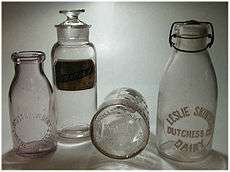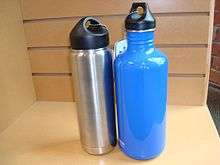Reuse of bottles

A reusable bottle is a bottle that can be reused, either for multiple trips to a bottler or is reused by a household. It is a common example of reusable packaging.
Background, history

Early glass bottles were often reused: milk, water, beer, soft drinks,yoghurt etc. Mason jars were developed for home canning and reused several times.
With returnable bottles, a retailer would often collect empty bottles or would accept empty bottles returned by customers. Bottles would be stored and returned to the bottler in reusable cases or crates. Some regions have a container deposit which is refunded after returning the bottle to the retailer. At the bottler, the bottles would be inspected for damage, cleaned, sanitized, and refilled.
More recently, many bottles have been designed for single use. This often allows for thinner glass bottles and less expensive plastic bottles and aluminum beverage cans. Recycling rates have been increasing, particularly for aluminum. On a cost basis, the decision has often been made for non-returnable bottles.
Environmental comparisons

The reuse of containers is often thought of as being a step toward more sustainable packaging. Reuse sits high on the waste hierarchy. The container is used many times thus the material per use or per filling cycle is reduced.
Many potential factors are involved in environmental comparisons of returnable vs non-returnable systems. Researchers have often used life cycle analysis methodologies to balance the many diverse considerations. Often the comparisons show no clear winner but rather show a realistic view of a complex subject.[1][2]
Bottles intended for reuse by households


Some bottles are sold empty to consumers with the intent for them to be used many times. These can be made of glass, metals, and a variety of plastics and can contain a variety of beverages. The consumer should wash the bottle and bottle cap after each use to assure proper sanitation.
Some baby bottles have an inner bag or bladder which is replaced after each use.
Reuse of bottles intended for a single use
Some consumers wash and reuse plastic or glass bottles intended for a single use. Often this is for water bottles, but it can be for a variety of uses, including juices or other drinkable liquids.
Bacterial concerns
Reused bottles could develop bacteria in the bottle between uses. Mouth contact to the bottle openings can easily transfer bacteria to the water content, which can contaminate both bottle and water. Contamination will cause bacterial and fungal growth in the water while kept in storage; if the user cleans the bottle thoroughly before reuse, the risk is much less.[3]
Some experts state that there's generally no harm in reusing your own water bottle, but the risk for ingesting harmful bacteria increases if you share your water bottle. University of Nebraska Medical Center Microbiologist Pete Iwen, Ph.D., says, “If it’s my bottle, my germs, I probably would not be all that paranoid about reusing the bottle. The main issue occurs when sharing bottles. Microbes present in my mouth may be harmful to others.” [4]
Other chemicals of concern
Bisphenol A (BPA) can be a concern for some bottles made of polycarbonate (which shares resin identification code 7 with other plastics). High temperatures and bleaching are believed to increase leaching of BPA. Several countries have banned the use of plastics containing BPA used for water and other food items. Leaching of phthalates from PVC (resin identification code 3) is also a concern, but PVC is not typically used for water bottles.
Carcinogen Misconception
A university student's master's thesis falsely suggested that repeatedly rewashing plastic water bottles can lead to the leaking diethylhydroxylamine (DEHA) into the drinking water, and can be detrimental to human health.[5] The results of this research were repeated by various sources and also became a chain email, later declared to be a hoax.[6][7][8]
The American Cancer Society and Cancer Research UK have stated that DEHA is not present in plastic water bottles; even if it were, it is not a known carcinogen.[6][9]
See also
References
- ↑ Singh, J; Krasowski, Singh (January 2011), "Life cycle inventory of HDPE bottle-based liquid milk packaging systems", Packaging Technology and Science: 49–60, doi:10.1002/pts.909, retrieved 11 October 2012
- ↑ Van Doorsselaer, K; Fox (2000), "Estimation of the energy needs in life cycle analysis of one-way and returnable glass packaging", Packaging Technology and Science: 235–239, doi:10.1002/(SICI)1099-1522(199909, retrieved 11 October 2012
- ↑ "Chemicals, Nutrients, Additives, & Toxins: Plastic water bottles". New Zealand Ministry for Primary Industries. Retrieved 26 September 2012.
- ↑ "UNMC expert says wash reused water bottles to avoid bacteria, viruses; don't share them". University of Nebraska Medical Center. Retrieved 13 February 2015.
- ↑ Lilya, Deena (2001). "Analysis and risk assessment of organic chemical migration from reused PET plastic bottles". Thesis (M.S.). University of Idaho, Moscow: 180. OCLC 49613368. Archived from the original on 2012-09-26.
- 1 2 "Plastic bottles". Cancer Research UK. Retrieved 7 October 2012.
- ↑ "Reusing Plastic Bottles Causes Cancer Hoax". Hoax-Slayer.com. Retrieved 26 September 2012.
- ↑ "FAQs: The Safety of Plastic Beverage Bottles". American Chemistry Council.
- ↑ "Plastic Water Bottles", American Cancer Society, archived from the original on 6 October 2012
Books, general references
- Yam, K. L., "Encyclopedia of Packaging Technology", John Wiley & Sons, 2009, ISBN 978-0-470-08704-6